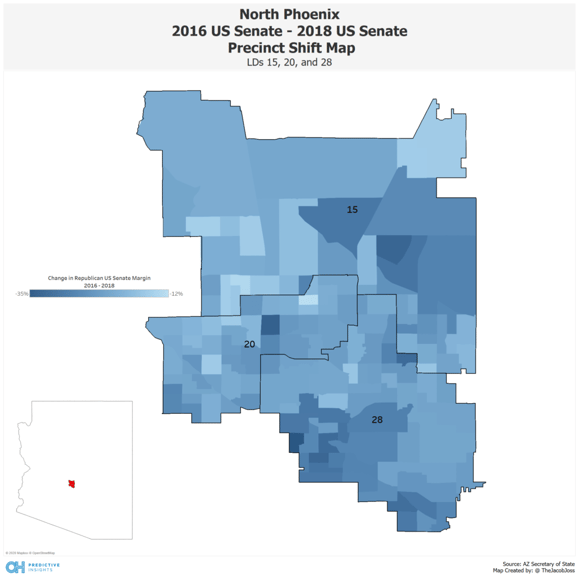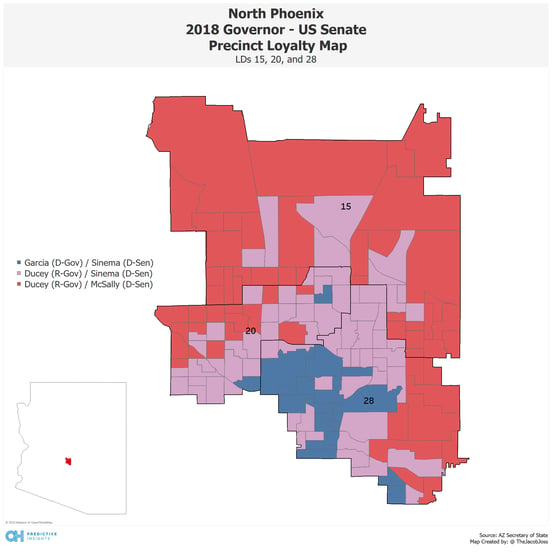Analysis: The Swinging Suburbs
Analysis: The Swinging Suburbs
How 3 Phoenix LD’s Have Turned Arizona into a Battleground State
A trio of legislative districts in the North Phoenix suburbs is going to play a key role in determining control of the Arizona State Legislature in 2020.
The districts – Arizona’s 15th, 20th, and 28th – have traditionally been Republican strongholds but have not been immune to the nationwide trend of suburban voters shifting away from the Republican Party. Before the 2018 election, 5 of the 6 House seats in these 3 districts were in Republican hands. After 2018 that number had fallen to 4. However, in the 2018 election for the 20th District’s House seats, Democrats lost by a razor-thin margin of fewer than 2,000 votes. All signs point to an even closer election this time around.
The results of how these three districts voted in two 2018 statewide races shines a light on which direction they – and Arizona as a whole – are trending and what types of candidates will be able to win them in the future.
To highlight just how much these suburban districts have moved in the Trump Era, one only has to look at the change in Republican performance in Arizona’s two most recent Senate elections – John McCain’s 2016 victory over Ann Kirkpatrick and Kyrsten Sinema’s 2018 win over Martha McSally. In no single precinct across the region did McSally overperform McCain’s 2016 margin. In fact, she did at least 10 points worse than McCain in each of the 146 precincts within the three districts. Overall, the region shifted leftward by 22 points after McCain’s 57-37 win over Kirkpatrick in 2016. By 2018, the area transformed into a 2 percent (50-48) Sinema victory.

However, these districts are still willing to elect Republicans by wide margins. For instance, in the race for Governor, the Republican incumbent, Doug Ducey carried this group of legislative districts 57-41 over Democratic challenger, David Garcia. He also carried each individual district by anywhere from 8 to 26 points. On the other hand, in that year’s Senate Election, Democrat Kyrsten Sinema narrowly won the region 50-48 over Republican Martha McSally. Sinema won the 20th and 28th districts by 3- and 12-point margins respectively, while only losing by 8 points in the 15th district.

The map above shows how the individual precincts which comprise the legislative districts voted in the two elections. A dark red precinct was won by Republicans in both races, a dark blue one was won by both Democrats. The purple areas are where the rubber meets the road when it comes to persuading voters – precincts won by Doug Ducey in the gubernatorial race but that voted for Kyrsten Sinema to replace Jeff Flake as Arizona’s next Senator. These 68 precincts represent the type of voters who are going to be determinative in future elections in Arizona. Voters for whom candidates who support Medicare for All and were endorsed by Bernie Sanders, like David Garcia, are considered far left, but those who are viewed as too close to President Trump, like Martha McSally, are considered far right.
Overall, Arizona’s 15th, 20th, and 28th legislative districts are going to be consequential for any candidate who hopes to win statewide in Arizona. In the 2016 elections for President and Senate, the collection of districts voted to the right of the state as a whole – giving President Trump and John McCain larger margins than they earned statewide. However, by 2018 they had cemented themselves in the “moderate” camp – voting for both Governor Ducey (R) and now-Senator Sinema (D). Ducey and Sinema were both were perceived to be less extreme than their challengers, despite being members of different parties.
These districts’ preference for moderate candidates should serve as a warning to both parties in the battle for the Arizona State House in 2020. Democrats only need to flip 2 seats in order to have a majority in the chamber for the first time since 1966 and, on paper, these districts are prime pickup opportunities.
However, Republicans are not in a bad position. The districts are traditionally Republican and have proven as recently as 2018 that they are willing to elect Republicans by wide margins. Yet simply “being Republican” is not enough to win here. The region has shown its willingness to vote for a Democrat who is seen as independent (like Kyrsten Sinema) over a Republican it feels is too extreme (like Martha McSally). Nevertheless, it is clear that for the Presidency, a Senate seat, and the State House majority, the path to victory in 2020 runs through these North Phoenix suburbs.
If you need mapping analysis for your district, schedule a quick call with our Chief of Research, Mike Noble.
